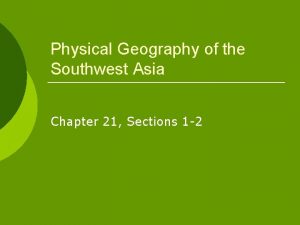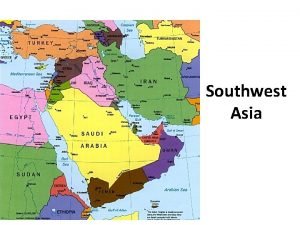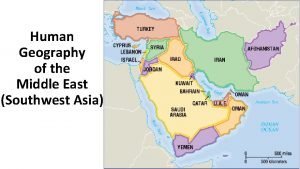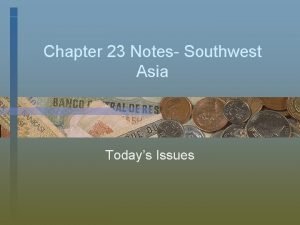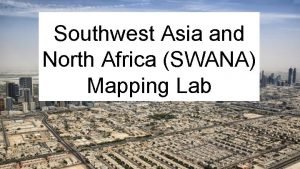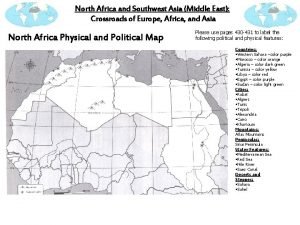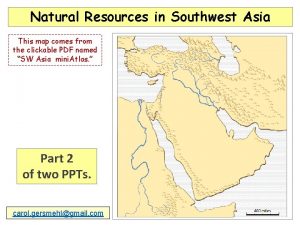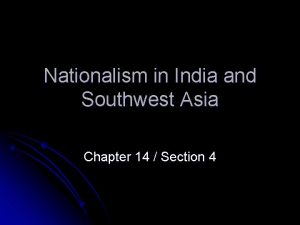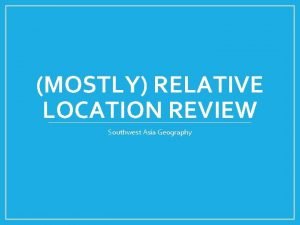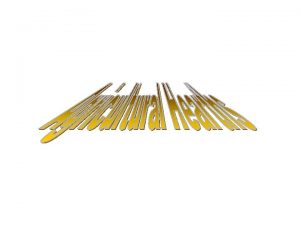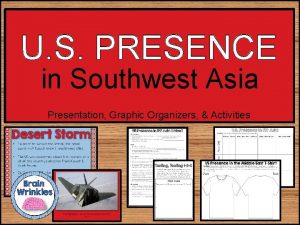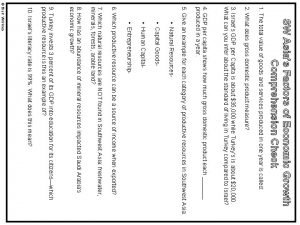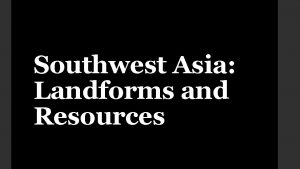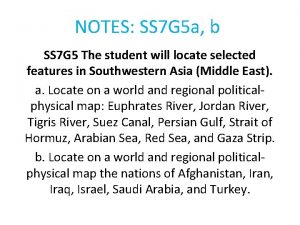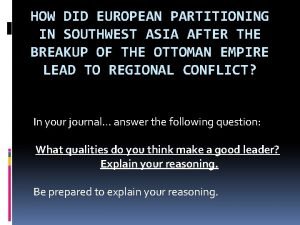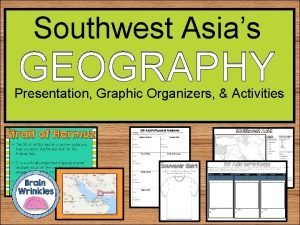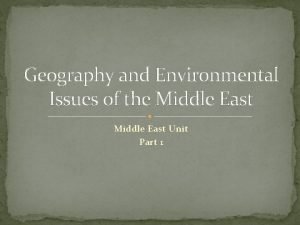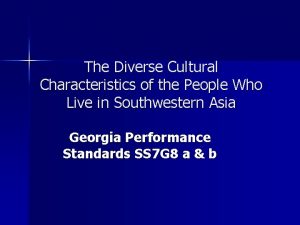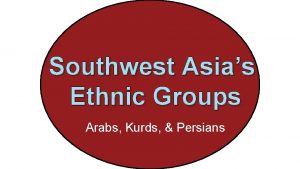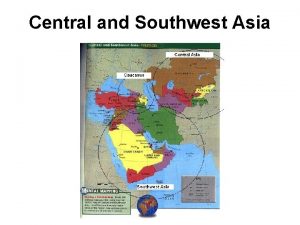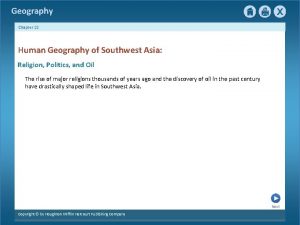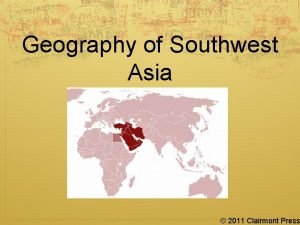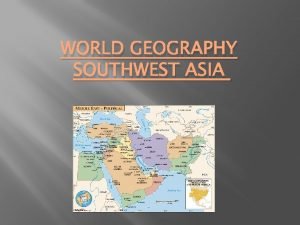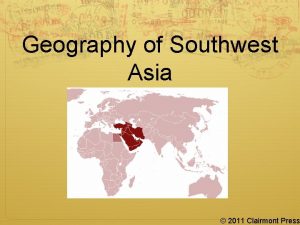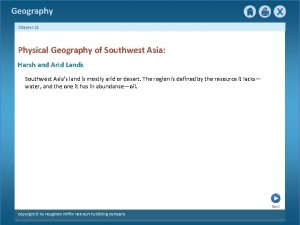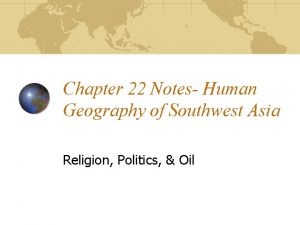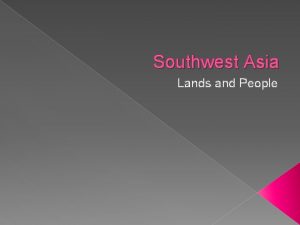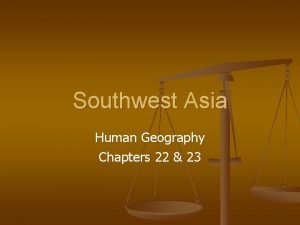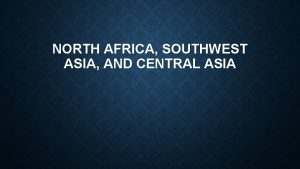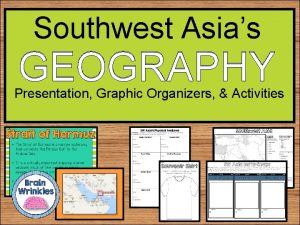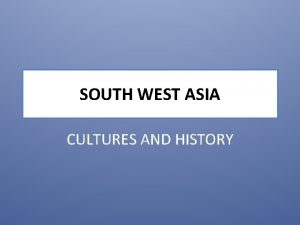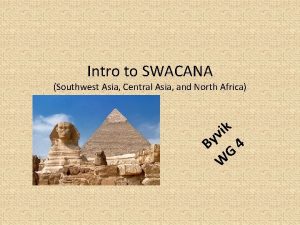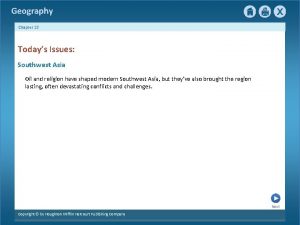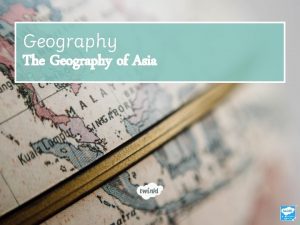Geography Chapter 22 Human Geography of Southwest Asia
































- Slides: 32

Geography Chapter 22 Human Geography of Southwest Asia: Religion, Politics, and Oil The rise of major religions thousands of years ago and the discovery of oil in the past century have drastically shaped life in Southwest Asia. Next Copyright © by Houghton Mifflin Harcourt Publishing Company

Geography Chapter 22 Human Geography of Southwest Asia: Religion, Politics, and Oil SECTION 1 The Arabian Peninsula SECTION 2 The Eastern Mediterranean SECTION 3 The Northeast Previous Copyright © by Houghton Mifflin Harcourt Publishing Company Next

Geography Chapter 22 Section-1 The Arabian Peninsula • The Arabian Peninsula is heavily influenced by the religious principles of Islam. • Oil production dominates the economy of the region. Previous Copyright © by Houghton Mifflin Harcourt Publishing Company Next

Geography Chapter 22 Section-1 The Arabian Peninsula Islam Changes Desert Culture Modern Nations of the Subregion • Bahrain, Kuwait, Oman, Saudi Arabia • Qatar, United Arab Emirates, Yemen Town and Desert • Bedouin nomads moved from oasis to oasis, built strong family ties − fought with other families, developed fighting skills • Fighting skills helped spread new monotheistic religion of Islam − religion based on teachings of founder, the Prophet Muhammad − Muhammad lived in Mecca, Islam’s holiest city Previous Copyright © by Houghton Mifflin Harcourt Publishing Company Continued… Next

Geography Chapter 22 Islam Changes Desert Culture {continued} Islam Brings a New Culture • The Five Pillars are required of all Muslims; create common culture • Faith—all believers must testify: − “There is no God but Allah, and Muhammad is the Messenger of Allah” • Prayer—pray facing Mecca five times a day; mosque—place of worship • Charity—give money to the less fortunate • Fasting—in the holy month of Ramadan, don’t eat, drink during day • Pilgrimage—all Muslims should make hajj to Mecca once in their life Previous Copyright © by Houghton Mifflin Harcourt Publishing Company Continued… Next

Geography Chapter 22 Islam Changes Desert Culture {continued} The Spread of Islam • Armies of Bedouin fighters move across desert − conquer desert lands, put Muslim leaders in control − spread Islamic teachings, Arabic language and culture • Muslim armies spread across Asia, Africa, Europe − by Middle Ages, large area of world is Muslim controlled Previous Copyright © by Houghton Mifflin Harcourt Publishing Company Next

Geography Chapter 22 Governments Change Hands Colonial Powers Take Control • Muslim governments were theocratic—religious leaders were in control − still true in some modern nations, such as Iran • In late 1600, Muslim nations weaken − Britain, France control most of region after WWI, fall of Ottomans − colonial value: Suez Canal is vital link; oil discovered (1932) • Abdul al-Aziz Ibn Saud takes control of most of Arabian Peninsula − becomes Saudi Arabia in 1932 Previous Copyright © by Houghton Mifflin Harcourt Publishing Company Next

Geography Chapter 22 Oil Dominates the Economy OPEC • Oil is principle resource of economy, makes region globally important − source of almost all of nations’ export money, GNP • In 1960, oil-producing nations form economic group − OPEC—Organization of Petroleum Exporting Countries − coordinate petroleum-selling policies, control worldwide oil prices − includes Saudi Arabia, Kuwait, Qatar, United Arab Emirates, Iran, Iraq Previous Copyright © by Houghton Mifflin Harcourt Publishing Company Next

Geography Chapter 22 Modern Arabic Life The Change to Urban Life • Rapid development as technology undermines traditional lifestyles − trucks replace camels; malls replace marketplaces • Villagers, farmers, nomads move into cities − 25% urban in 1960; 58% by 1990 s; estimated 70% by 2015 − Saudi population 83% urban • Oil jobs require skilled workers educational systems can’t provide − foreign workers brought in Previous Copyright © by Houghton Mifflin Harcourt Publishing Company Continued… Next

Geography Chapter 22 Modern Arabic Life {continued} Religious Duties Shape Lives • Women often cover their heads, faces with scarf, veil − women’s roles are slowly expanding: more are educated, working • Prayers performed dawn, noon, mid-afternoon, sunset, before bed − attend mosque services on Fridays • Fasting in Ramadan reinforces spirituality, self-control, humility − ‘Id al-Fitr marks end of Ramadan with gifts, dinners, charity Previous Copyright © by Houghton Mifflin Harcourt Publishing Company Next

Geography Chapter 22 Section-2 The Eastern Mediterranean • The holy places of three religions are found in this subregion. • There is a great deal of political tension among nations in this subregion. Previous Copyright © by Houghton Mifflin Harcourt Publishing Company Next

Geography Chapter 22 Section-2 The Eastern Mediterranean Religious Holy Places Jewish Presence • Jerusalem is a holy city to all three major monotheistic religions • Jerusalem is capital of Israel; center of modern, ancient homeland • Temple Mount in old city housed earliest temples − King Solomon’s First Temple − Second Temple built in 538 B. C • Today Jews pray at Western Wall (Wailing Wall) − sole remainder of Second Temple (destroyed by Romans in A. D. 70) Previous Copyright © by Houghton Mifflin Harcourt Publishing Company Continued… Next

Geography Chapter 22 Religious Holy Places {continued} Christian Heritage • Jerusalem is sacred site of Jesus’ crucifixion − nearby towns, villages were important in Jesus’ life • Christians visit Mount of Olives, Church of Holy Sepulchre • In Middle Ages, they fought Crusades to regain lands from Muslims − Muslims eventually regained control of the area − They maintained control until establishment of Israel in 1948 Previous Copyright © by Houghton Mifflin Harcourt Publishing Company Continued… Next

Geography Chapter 22 Religious Holy Places {continued} Islamic Sacred Sites • Jerusalem is third most holy Muslim city after Mecca, Medina • Dome of the Rock—shrine where it’s believed Muhammad rose to heaven − Jews believe it’s site where Abraham prepared to sacrifice Isaac • Dome and Al-Aqsa mosque are located on Temple Mount by Western Wall − close proximity of holy sites fosters Jewish-Muslim clashes Previous Copyright © by Houghton Mifflin Harcourt Publishing Company Next

Geography Chapter 22 A History of Unrest The Legacy of Colonialism • Ottoman Empire ruled region from 1520 to 1922, but weakened • Britain, France got lands after WWI defeat of Ottomans, Germany − France took Lebanon, Syria; Britain took modern Jordan, Israel • Both supposed to rule only until areas are ready for independence − France intentionally stoked religious tensions between groups − Lebanon became independent in 1943, Syria in 1946 Previous Copyright © by Houghton Mifflin Harcourt Publishing Company Continued… Next

Geography Chapter 22 A History of Unrest {continued} British Control Palestine • Zionism— 19 th-century movement for a Jewish homeland in Palestine − Jews buy land, begin settling • After WWI, British control area; Arabs, Jews cooperate − German persecution increases number of Jewish immigrants − Arabs begin to resist Jewish state • Area is divided: Transjordan is ruled by Arab government and British − Palestine is ruled by British with Arab, Jewish local governments Previous Copyright © by Houghton Mifflin Harcourt Publishing Company Continued… Next

Geography Chapter 22 A History of Unrest {continued} Creating the State of Israel • After WWII, many Jewish Holocaust survivors settle in Palestine − UN divides Palestine into two states: one Jewish, one Arab • Israel is created in 1948; repels invasion by Arab states • Palestinian Arabs flee − Palestinian land on West Bank, Gaza Strip is controlled by Israel • Palestine Liberation Organization (PLO) uses politics, military to: − regain land in, and return of refugees to, Israel Previous Copyright © by Houghton Mifflin Harcourt Publishing Company Next

Geography Chapter 22 Modernizing Economies Refugees and Civil Wars • Creation of Israel produces numerous Palestinian refugees − today they number 3. 6 million across the region; some in camps − many struggle for food, shelter, jobs; lack education − Jordan has the largest Palestinian refugee population • Civil wars in Lebanon, Cyprus cause economic problems − Lebanon war in 1975– 76 led to Israel invading Lebanon in 1982 Previous Copyright © by Houghton Mifflin Harcourt Publishing Company Continued… Next

Geography Chapter 22 Modernizing Economies {continued} Modern Infrastructure • Region’s nations have potential for development − climate for citrus crops, sites for tourism − location connects them to markets in Europe, Asia, Africa • Many nations lack infrastructure to support growing economy − irrigation is needed for agriculture − communication systems, power sources needed for industry • Israel has built sophisticated industries, like computer software Previous Copyright © by Houghton Mifflin Harcourt Publishing Company Next

Geography Chapter 22 2 Modern Life {continued} Eating Out, Eating In • People don’t eat in restaurants as much as in U. S. − some restaurants have separate male, female sections − cafés are usually for men only • Most meals are eaten at home, with dinner between 8– 11 pm • Meals include hummus (ground chickpeas), baba ganouzh (eggplant dip) − cracked wheat tabbouleh salad; chicken, lamb rather than beef − dessert of fruit, kolaicha (sweet cake) Previous Copyright © by Houghton Mifflin Harcourt Publishing Company Continued… Next

Geography Chapter 22 Modern Life {continued} A Variety of Cultures • Lebanon has mostly Shi’ite Muslims and some: − Druze, a secretive religious group living in mountainous areas − Maronite, Eastern Orthodox Christians • Lebanon’s cultural, religious variety makes unity difficult • Culturally, Israel is Jewish, but is also home to other groups − Bedouins, Druze, Sunni, Circassians (from Caucasus region) − some Christians, Baha’i Previous Copyright © by Houghton Mifflin Harcourt Publishing Company Next

Geography Chapter 22 Section-3 The Northeast • The nations in this subregion are Muslim but most are not part of the Arab culture. • The nations in the Northeast range from developed to very poorly developed. Previous Copyright © by Houghton Mifflin Harcourt Publishing Company Next

Geography Chapter 22 Section-3 The Northeast A Blend of Cultures Nations of the Region • Turkey, Iran, Iraq, Afghanistan Early Civilizations • Iraq’s Fertile Crescent between Tigris, Euphrates a cultural hearth − early civilizations include Sumer, Babylonia, Assyria, Chaldea − all built empires in Mesopotamia, the “land between the rivers” • Hittite empire covered modern Turkey, introduced iron weapons • Persian empire developed in what is now Iran − introduced innovations in governmental organization Previous Copyright © by Houghton Mifflin Harcourt Publishing Company Continued… Next

Geography Chapter 22 A Blend of Cultures {continued} Ethnic and Religious Variety • Subregion’s ethnic groups include Turks, Kurds, Persians, Assyrians − languages (Turkish, Farsi) are different from Arabic • All groups (except Assyrians) are Islamic, but tensions exist − after Muhammad’s death, Muslims divided into two branches − 83% of all Muslims are Sunni; most Iranians are Shi’ite Previous Copyright © by Houghton Mifflin Harcourt Publishing Company Next

Geography Chapter 22 Clashes Over Land Homelands and Refugees • Kurds—stateless ethnic group located in Turkey, Iraq, Iran − promised homeland after WWI, but never got it • Iran has world’s largest refugee population − Iraqi Shi’ites flee persecution − decades of war create Afghan refugees Control of Oil Fields • In 1980 s, Iran, Iraq fight war over Persian Gulf oil fields • Iraq invades Kuwait in 1990; driven out in Persian Gulf War Previous Copyright © by Houghton Mifflin Harcourt Publishing Company Next

Geography Chapter 22 Clashes Over Leadership Overthrow of the Taliban • Taliban—fundamentalist Muslim political group rules Afghanistan − protects Osama bin Laden and al-Qaeda terrorist network • After 9– 11 attacks, U. S. attacks Afghanistan in October 2001 − Operation Enduring Freedom targets terrorist assets, infrastructure − Taliban removed from power by March 2002 − Hamid Karzai heads transitional government − Osama bin Laden and some Taliban leaders escape Previous Copyright © by Houghton Mifflin Harcourt Publishing Company Continued… Next

Geography Chapter 22 Clashes Over Leadership {continued} Overthrow of Saddam Hussein • After Gulf War, UN orders Iraqi dictator Saddam Hussein to disarm − ordered to destroy chemical, biological weapons • President George W. Bush turns focus to Iraq in 2002 − Bush believes Hussein has weapons of mass destruction − U. S. , U. K. attack Iraq in Operation Iraqi Freedom, March 2003 − major fighting ends in May 2003; Hussein captured in December 2003 Previous Copyright © by Houghton Mifflin Harcourt Publishing Company Next

Geography Chapter 22 Reforming Economies Making Progress • Turkey is developing water resources, hydroelectric plants − supply energy, boost cotton and other agricultural production − only nation in region that produces steel − location between Europe, Asia is ideal for trade • Changes in Iran’s government bring economic progress − current government supports change − oil money funds development Previous Copyright © by Houghton Mifflin Harcourt Publishing Company Continued… Next

Geography Chapter 22 Reforming Economies {continued} Progress Interrupted • Economic sanctions on Iraq after Gulf War limited trade − created shortages of food, medicine • Afghanistan is one of world’s poorest nations − most people farm or herd animals − mineral resources remain undeveloped due to civil wars, turmoil − post-Taliban transitional government is rebuilding economy Previous Copyright © by Houghton Mifflin Harcourt Publishing Company Next

Geography Chapter 22 Modern and Traditional Life Division and Struggle • Region’s nations face internal struggles − some seek modern lifestyle, others want to preserve traditions • In Afghanistan, Taliban had strict rules of behavior − new government is restoring civil liberties, improving education • Taliban-like groups in Turkey, Iran, Iraq have not gained power − differences have led to conflicts, political problems Previous Copyright © by Houghton Mifflin Harcourt Publishing Company Next

Geography Chapter 22 This is the end of the chapter presentation of lecture notes. Click the HOME or EXIT button. Previous Copyright © by Houghton Mifflin Harcourt Publishing Company Next

Geography Chapter 22 Print Slide Show 1. On the File menu, select Print 2. In the pop-up menu, select Microsoft Power. Point If the dialog box does not include this pop-up, continue to step 4 3. In the Print what box, choose the presentation format you want to print: slides, notes, handouts, or outline 4. Click the Print button to print the Power. Point presentation Previous Copyright © by Houghton Mifflin Harcourt Publishing Company
 Chapter 22 human geography of southwest asia
Chapter 22 human geography of southwest asia Chapter 21 physical geography of southwest asia
Chapter 21 physical geography of southwest asia Chapter 21 physical geography of southwest asia
Chapter 21 physical geography of southwest asia North africa and southwest asia physical geography
North africa and southwest asia physical geography Human geography of middle east
Human geography of middle east Chapter 23 today's issues southwest asia
Chapter 23 today's issues southwest asia Chapter 25 section 3 nepal and bhutan
Chapter 25 section 3 nepal and bhutan Brain wrinkles southwest asia
Brain wrinkles southwest asia Chapter 21 section 1 landforms and resources answer key
Chapter 21 section 1 landforms and resources answer key Swana map
Swana map Southwest asia and north africa map
Southwest asia and north africa map Political map of southwest asia and north africa
Political map of southwest asia and north africa Southwest asia natural resources
Southwest asia natural resources Nationalism in india and southwest asia
Nationalism in india and southwest asia Which southwest asian country is the farthest east
Which southwest asian country is the farthest east Southwest asia hearth
Southwest asia hearth Brain wrinkles southwest asia answer key
Brain wrinkles southwest asia answer key Voluntary trade comprehension check
Voluntary trade comprehension check Southwest asia comprehension check
Southwest asia comprehension check Difference between islam and christianity chart
Difference between islam and christianity chart Brain wrinkles southwest asia
Brain wrinkles southwest asia Dubai landforms
Dubai landforms Tigris river map
Tigris river map Republic in southwest arabia
Republic in southwest arabia Europe partitioning in southwest asia answer key
Europe partitioning in southwest asia answer key Geography of sw asia color by number
Geography of sw asia color by number Nationalism in india and southwest asia
Nationalism in india and southwest asia Nationalism in india and southwest asia
Nationalism in india and southwest asia Southwest asia map kuwait
Southwest asia map kuwait North africa southwest asia physical map
North africa southwest asia physical map Which ethnic group is most numerous in southwest asia
Which ethnic group is most numerous in southwest asia Ethnic groups
Ethnic groups Why is water pollution a great concern in southwest asia
Why is water pollution a great concern in southwest asia

